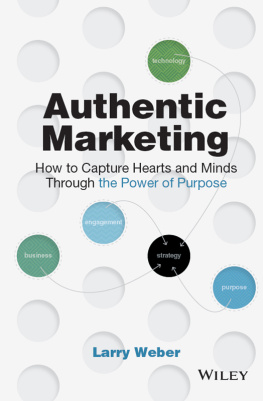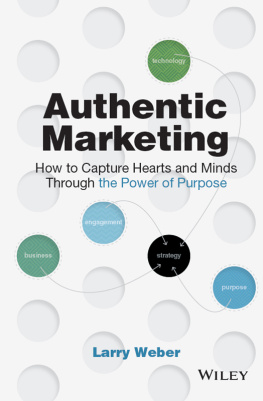Mass Moralizing
Mass Moralizing
Marketing and Moral Storytelling
Phil Hopkins
LEXINGTON BOOKS
Lanham Boulder New York London
Published by Lexington Books
An imprint of The Rowman & Littlefield Publishing Group, Inc.
4501 Forbes Boulevard, Suite 200, Lanham, Maryland 20706
www.rowman.com
Unit A, Whitacre Mews, 26-34 Stannary Street, London SE11 4AB
Copyright 2015 by Lexington Books
All rights reserved. No part of this book may be reproduced in any form or by any electronic or mechanical means, including information storage and retrieval systems, without written permission from the publisher, except by a reviewer who may quote passages in a review.
British Library Cataloguing in Publication Information Available
Library of Congress Cataloging-in-Publication Data
Hopkins, Phil, 1958
Mass moralizing : marketing and moral storytelling / Phil Hopkins.
pages cm.
Includes bibliographical references and index.
ISBN 978-0-7391-8851-4 (cloth : alk. paper) ISBN 978-0-7391-8852-1 (electronic) 1. Mass mediaMoral and ethical aspects. 2. CommunicationMoral and ethical aspects. 3. Marketing. I. Title.
P94.H658 2015
175dc23
2015000455
 TM The paper used in this publication meets the minimum requirements of American National Standard for Information Sciences Permanence of Paper for Printed Library Materials, ANSI/NISO Z39.48-1992.
TM The paper used in this publication meets the minimum requirements of American National Standard for Information Sciences Permanence of Paper for Printed Library Materials, ANSI/NISO Z39.48-1992.
Printed in the United States of America
List of Figures
Figure 1.1: | Website ad retrieved January 16, 2014 from online.wsj.com/media/mf03-amercent2.pdf, used with permission of American Century Investments Inc., American Century Services. | |
Figure 1.2: | Website ad retrieved March 15, 2011 from mcdonalds.com.au/#/families. | |
Figure 3.1: | Soldier, United Colors of Benetton campaign image, retrieved March 30, 2014 from adforum.com/creative-work/ad/player/21466. | |
Figure 3.2: | AIDS patient, United Colors of Benetton campaign image, retrieved March 15, 2011 from benettongroup.com/media-press. | |
Figure 3.3: | Bosnian soldier clothes, United Colors of Benetton campaign image, retrieved March 15, 2011 from benettongroup.com/media-press. | |
Figure 3.4: | Kenneth Cole Fall 2004 Campaign, retrieved April 4, 2014 from archive.kennethcole.com/timeline/2004-fall-campaign/1122. | |
Figure 3.5: | Kenneth Cole Fall 2004 Campaign, retrieved April 4, 2014 from archive.kennethcole.com/timeline/2004-fall-campaign/1122. | |
Figure 3.6: | Kenneth Cole Fall 2011 Campaign, retrieved April 4, 2014 from archive.kennethcole.com/timeline/2011-fall-campaign-1/1791. | |
Figure 3.7: | Starlet, magazine ad for Skyy Vodka, 1993. Image retrieved from richarddirk.com/blog/article/skyy-vodka-starlet on April 3, 2014. Original concept by Richard S. Dirk, Art Director, produced with Chad Farmer at the Lambesis Agency. Photography by Matthew Rolston. | |
Figure 4.1: | Drivers Wanted, magazine ad for Volkswagen Jetta, 20012002. Image retrieved from Advocate, December 10, 2002. Produced by Arnold Worldwide under the direction of Tesa Aragones, Advertising Manager, Brand Manager and Director of Media and Interactive Marketing for Volkswagen. | |
Figure 4.2: | Screen capture from Always One of a Kind, commercial for Dr. Pepper, accessed on August 27, 2012, from youtube.com/watch?v=0Ix7T_XIA28. | |
Figure 4.3: | Screen capture from Always One of a Kind, commercial for Dr. Pepper, accessed on August 27, 2012, from youtube.com/watch?v=0Ix7T_XIA28. | |
Figures 4.44.7: | Make your own ad, Curve perfume ad, retrieved from Seventeen, April 2007. | |
Figures 5.1: | Screen capture from Its a Beautiful Life, Lancme commercial, accessed on December 13, 2013, ispot.tv/ad/7L1q/lancome-la-vie-est-belle-featuring-julia-roberts. | |
Figure 7.1: | Every Stripe Tells a Story, accessed on June 22, 2011, blurppy.files.wordpress.com/2011/06/page_2.jpg. | |
Figure 7.2: | Real Women Have Real Curves, accessed April 12, 2010, ad-review.co.uk/view/image/item/doves_campaign_for_r/1287. | |
Figures 7.37.5: | Campaign for Real Beauty, accessed on May 28, 2014, archive.epica-awards.com/pages/results/2005/winners/results2005-cat16.html. | |
Acknowledgments
I want to thank the students in my many Media and Ethics classes for bringing a number of the ads and commercials analyzed in this book to my attention, and my daughter, Rebecca, for first calling my attention to the Lancme and French McDonalds ads. I want to thank her in particular for all the years of watching, analyzing, and discussing marketing together with me, and my son, Isaac, and wife, Lisa, for their tireless review of this work in progress and equal patience with my constant deconstructions of whatever we happened to be watching together. Some material in this book was originally published in different form in the chapter Mass Moralizing in Amir Hetsroni, Advertising and Reality (New York: Continuum Press, 2012) and is used with permission of Bloomsbury Academic. The American Century advertisement is used with permission of American Century Investments Inc., American Century Services. All other advertising material is used under the Fair Use Clause, Section 107, of the Copyright Act of 1976, which protects the unlicensed reproduction of media for the purposes of criticism, commentary, and education.
Introduction
What are the... implications of our whole form of life? Is the confusion about values and the absence of larger meanings that seem to characterize many Americans the result of life contexts that produce more confusion than clarity?
It is a well-established and much discussed fact that each of us encounters a great deal of mass media every day in what many refer to as our consumer culture. There is what amounts to a subsidiary industry whose primary task is reflecting upon media and our consumption of it. Since Marshall McLuhan famously informed us that the medium is the message, many others have addressed this powerful force in our lives, often decrying its vast influence and predicting no good to come of it.
One such alarmist, Jeffrey Scheuer, in The Sound Bite Society, warns that our electronic culture fragments information into isolated, dramatic particles and resists longer and more complex messages. These characteristics work against ambiguity and non-binary thinking and reasoning that appeals to causal, contextual, or environmental considerations, he argues. Scheuer believes that our sound bite culture in fact reinforces a contrary vision: one that focuses on the immediate and the obvious; the near-term and the particular; on identity between appearance and reality; and on the self rather than larger communities. Above all, he believes, it has created a society that thrives on simplicity and disdains complexity. While his specific conclusions about political party control of mass media discourses are indeed questionable, this analysis of its larger structural character is not wrong.
Next page











 TM The paper used in this publication meets the minimum requirements of American National Standard for Information Sciences Permanence of Paper for Printed Library Materials, ANSI/NISO Z39.48-1992.
TM The paper used in this publication meets the minimum requirements of American National Standard for Information Sciences Permanence of Paper for Printed Library Materials, ANSI/NISO Z39.48-1992.